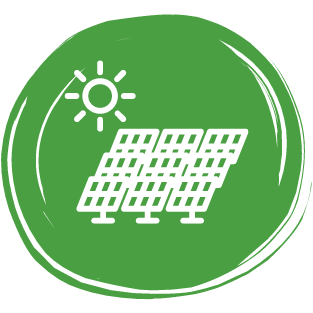With big, ambitious solar targets for 2025 and 2030, Ireland hopes to go from Europe's most reluctant solar energy producer to being a world leader in per-capita solar generation. No-one can question the scale of the ambition. But is it achievable? And how is Ireland's solar revolution going so far?

Like most EU and OECD countries, Ireland has made significant climate pledges over recent years. Mapping out the first stages of the journey to net zero, Ireland's Climate Action Plan 2024 sets out the country's biggest and boldest renewable energy targets yet. Here are some of the most significant commitments for Irish solar in particular.
By 2030, 80% of Ireland's Electricity is set to come from renewable sources. As well as solar, this includes 9 GW of onshore wind and 5 GW of offshore wind.
According to Ireland's Climate Action Plan, during 2025 the country should have "up to 5 GW" of solar capacity. The phrase "up to" may leave some wiggle room, but the target also calls for "at least 1 GW" of new non-utility solar. Non-utility solar includes any generator of less than 1 MW capacity. In effect, that means homes, industrial units, warehouses, hospitals, factories and so on.
Ireland's 2030 climate targets are most important for the solar industry. By that date, Ireland should have built 8 GW of solar capacity, including 2.5 GW of non-utility generation. In effect, this means Ireland will need the equivalent of 500,000 domestic solar arrays (currently, there are just under 100,000 homes with solar panels in Ireland). In practice, houses won't be the only contributors, of course. Larger solar arrays will also be needed. However, while the 2030 non-utility target is roughly equivalent to 12,500 warehouses or 2,500 factories, that is far more commercial rooftop space than there is in Ireland. So residential and commercial solar will need to expand significantly and in tandem if Ireland's solar goals are to be met.

When it released its first climate action plans, the Irish government was quite modest in its expectations for solar growth. In fact, the Climate Action and Low Carbon Development Act 2015 did not spefically set any targets or expectations for increased solar capacity. Four years later, the Climate Action Plan 2019 called for 1.5 GW of solar capacity by 2030. This is a fairly unambitious aspiration for an OECD country, and Ireland could quite easily have met it ahead of schedule. However (perhaps for that reason) later Action Plans saw the target increase to 2.5 GW (in 2023) and again to 8 GW (in 2024).
The updated Climate Action Plan 2024 was a call to arms for the solar industry, effectively calling for an overnight rooftop revolution. This renewed ambition triggered a significant uptick in solar capacity, but much work is to be done if Ireland's 2030 solar targets are to be anything more than notional aspirations.
The short answer is "No" — at the time of writing (October 2024 ), Ireland is very far behind its solar targets for 2025. Based on current data, it seems very unlikely that Ireland will reach its 2025 targets, meaning even more drastic action will be required to 'play catch-up' and meet the even more significant commitments laid out for 2030.
The chart below shows how Ireland currently has just over 50% of the non-utility solar capacity that it has pledged to build by the end of 2025. (Non-utility capacity includes all Ireland's solar installations on homes, businesses, and other small-scale generators with a capacity below 1 MW.) Effectively, to meet the 2025 non-utility goal of 1 GW, Ireland would need (in just one year) to add as many solar panels to its homes and businesses as it did over the past decade. Not impossible but certainly unlikely.
In the utility sector, the situation is even more pressing. Utility solar generators include all installations above 1 MW (like solar farms). Ireland is committed to building 4 GW of utility solar capacity by the end of 2025. So far, in October 2024, built 0.66 GW or 16.5% of its target amount.
Yes, the good news is that Ireland's rate of solar uptake is improving. The 2024 Action Plan may have asked for more than Ireland could deliver in a year, but it arguably provided the shot in the arm that Irish solar really needed.
The graph below shows Ireland's accumulated solar capacity over time. What began as a fairly flat line has seen a notable upward acceleration which seems to correlate with the publication of the 2023 and 2024 Action Plans. For the 2030 target of 8 GW to be met, this upward acceleration will need to continue and Ireland will need to build approximately 1.2 GW of solar capacity every year from 2025. This assumes that Ireland can claim success if it reaches its goal by the end of 2030 (i.e. not by the start of 2030).

From a low baseline, the number of solar panels in Ireland is quickly increasing. That's the good news. The bad news is that it really needs to: out of 27 EU member states, Ireland ranks 24th for accumulated solar capacity.
As the chart below shows, there are a great many homes in Ireland that do not have solar panels on them. Supported by a government grant of up to €1,800, around 750 Irish homeowners are adding solar panels to their roofs weekly (source ). That's 39,000 homes per year. So, in 2025 alone, Ireland should increase its accumulated total of solar PV homes by 40% — all in just one year.
And there are a lot of roofs sitting empty! The below chart shows that 92% of Ireland's homes and bungalows do not have solar panels. Of course, not every house is suitable for solar. But most are, and so there is huge potential for Ireland to increase its solar uptake. At the current rate, adding solar panels to just half of Ireland's homes and bungalows would take about 40 years.
So there are plenty of houses with no solar panels and Ireland has big non-utility solar targets to fulfil. The government must be pulling out all the stops to incentivise solar uptake, right?
Wrong.
For 2025, the SEAI solar grant is going down, not up. Right when we need more Irish homeowners to step up and invest in solar, government support for doing so is shrinking. If Ireland is to meet its 2030 target of 2.5 GW non-utility solar, this is a policy which legislators may need to review.

To meet its 2030 commitments, Ireland needs to build around 5 GW of non-utility solar capacity in the next six years — a 1000% increase on all the solar farms it has built. This is a significant undertaking, and it appears that policymakers and industry representatives are approaching it with serious intent.
In Q2 of 2024, Ireland had contracted 3.6 GW of utility-scale solar generators . This means that, at that time, there were ongoing developed plans to build solar farms of that combined scale. Of course, not all of these projects will be successful. Some projects will face local planning objections, while others may be unfeasible for various reasons. However, it's a bold and ambitious effort aiming to steer Irish solar energy in the right direction for 2030.
As the above chart shows, Ireland has significantly more utility-scale solar projects in the pipeline ("contracted") than are currently connected to the grid. This is a trend it will need to continue and build upon if the 2030 target of 5.5 GW is to be achieved.
Even if 100% of Ireland's currently planned solar farms went on to be connected to the grid, that would still only take the country's utility-scale solar capacity up to 4.2 GW — 1.3 GW short of the 2030 goal.
Given that projects like these tend to progress slowly, and not all of them will be successful, industry leaders and policymakers will need to be even bolder in finding suitable utility-scale solar projects throughout Ireland.

It's hard to overstate the number of new solar panels Ireland needs to meet its set targets. The increase in capacity between now and 2030 is equivalent to 15 million domestic solar panels.
Of course, not many of the actual solar panels will be domestic grade. Strategically, Ireland has opted to bias heavily towards utility-scale installations and, to a large degree, this makes a lot of sense. Big solar generators are more efficient and they are also under the direct control of the country's industrial and political leaders. It's hard for a government to make its citizens go solar, but (through tax breaks and schemes like the Renewable Electricity Support Scheme or 'RESS' ) it can quite easily create the right market conditions for the energy giants to pick up the slack.
At this utility scale, Ireland needs to go even further. Many of its planned solar farms will never be connected to the grid. So it needs to make up for the expected attrition rate and go further to reach the hugely ambitious goal of 5.5 GW by 2030.
Of course, smaller-scale projects also have a huge role to play. Arguably, it's now time for Ireland's homes and businesses to take the lead and embrace the potential that solar energy offers. Putting solar panels on your own roof is more than just an act of public service. It's an investment in your own energy independence.
If 92% of Irish houses continue to rely on the grid for their day-to-day energy needs, the people of Ireland will remain at the mercy of market forces long term. As the last few years have shown us, having your own solar panels on your own roof can be more than just 'doing your bit' — it's also a way of protecting yourself against energy market volatility.
As it continues to promote utility-scale solar through incentives, it will be interesting to see if the Irish government revisits its plans to phase out support for domestic PV installations. For more information about PV as a long-term investment, check out our guide about the cost of solar panels in Ireland.

This is a free resource commissioned and funded by PureVolt Solar Ireland. The Eco Hub has been developed by our green energy experts in collaboration with the engineers, scientists, and data specialists from our sister company SquareFish .
On pages like this one, we try to share our passion and motivations for a greener Ireland by presenting clear, factual information without getting on a soapbox. We hope this page is useful for you. Please get in touch to let us know if we can make it better :)